This is about the most powerful but least understood force in B2B marketing.
It’s about untapped potential that every brand can tap… but very few do.
And it’s far from a secret. We’ve all seen it work over and over and over again to launch top brands above their crowded markets and into a new place. A place where all marketing becomes much easier because it meets a lot less resistance.
That thing is… well, you know what it is because you’ve already read the title of this post. (Save you scrolling: it’s Tone of Voice).
Throughout my entire career in marketing (most of it in B2B), I’ve been baffled by how rarely tone of voice is used to make brands more approachable, memorable, likeable and buy-from-able.
This turns out to be a good thing, because the brands that do understand the power of voice have a big, fat advantage over those who just don’t get it. (It’s always been an important part of what we bring to our clients).
This quote nails it:
Tone of voice is the single biggest opportunity facing every marketer—but it’s hidden in a footnote at the bottom of the marketing strategy (if it’s in there at all).
— Me, just now
Think of your favorite brands—B2B or consumer. They all have it: a clear, compelling, consistent voice. That’s not a coincidence. They’re your favorite brands because they have the likeable personality that voice conveys. And, as ‘soft’ as that sounds, it’s actually as hard and real as MQLs in a funnel and money in a bank.
Tone of voice as a budget multiplier
This will sound like a gross exaggeration but I believe it’s an understatement: a clear, compelling voice will multiply the impact of your marketing.
A smart timely, insightful story can be killed stone dead by a flaccid voice. And the same story can go ape-shit viral when told in a bright, surprising, confident voice.
(We know, we’ve written both kinds. The dull stuff that drops from view soon after release and the snappy, joyful stuff that soars, taking on a life of its own.)
In short, voice can multiply your budget.
Let that phrase sink in. Multiply your Budget.
The formula is simple:
Story x Voice = Impact
The multiplication sign is the key here: if either value is zero, the total is zero too.
A great story told in wet-noodle-speak will fall like that zen tree in that human-free forest. And a tired, borrowed, oft-told story told in sizzling prose… flops too.
But get them both right—a fresh, timely story (or super-helpful guide) told in a delightful, confident voice—and the sky isn’t even the limit.
A whispered aside:
Voice is not the only thing you need to master if you want to create a loved, lasting brand. What you actually do is pretty important too (we wrote about stance, the companion to voice, in this post: Beyond Tone of Voice: What’s Your Stance?). But if you’re doing lots of interesting things that add real value to customers, then voice is your performance-enhancing drug. If you don’t use it, the runner in the next lane will. And she will kick your butt.
Tone of voice is the real content in your content
All the best consumer brands get it. But for too many B2B brands, voice is the confectioners sugar of the marketing cake—something you sprinkle on at the end (if it’s in the recipe at all).
In fact, it’s impossible leave voice out of your content. It’s always there, sending a message—and may well be the most important message you send.
This highly scientific chart (uniquely generated without recourse to AI), shows what I mean:
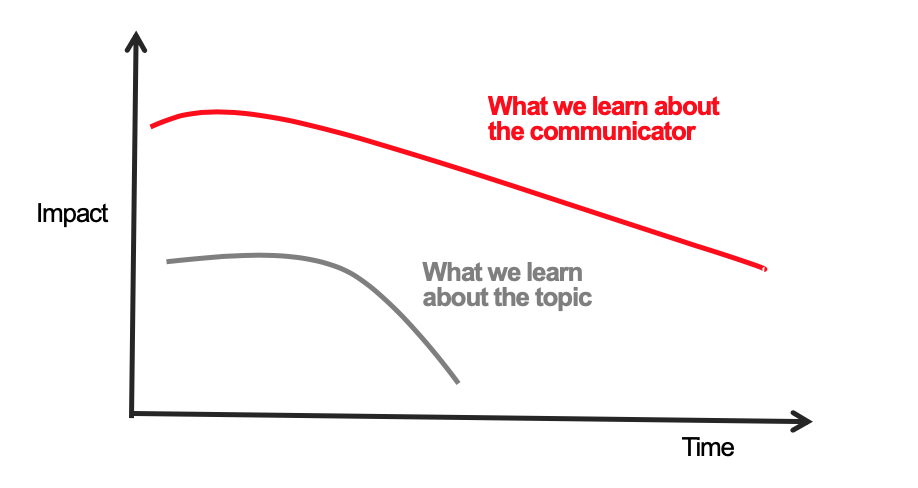
When you consume a piece of content, the things you learn from it make a small impact that fades pretty quickly. But your feelings about the communicator make a bigger impact that lasts longer. And most of those feelings come from the signals sent by tone of voice.
“People may not remember exactly what you did, or what you said, but they will always remember how you made them feel.”
Attributed to Maya Angelou
Another pause to let that sink in.
The things in your content that people really feel and really remember are the nearly invisible signals that come not from what you say but from how you say it.
In other words:
Tone of voice may be the most important content in your content.
Tone of voice as social signal
Why is tone of voice so powerful?
Because humans are social animals. We evolved to be extremely sensitive to any signal from any member of our species that tells us about their intentions, motivations and character.
Humans who were good at this skill survived for long enough to produce more humans. Humans who weren’t good at it got clobbered by concealed, Flinstonian cudgels before they could make kids.
When a real person is talking to us, there are a lot of different channels that carry these intent/motivation/character signals:
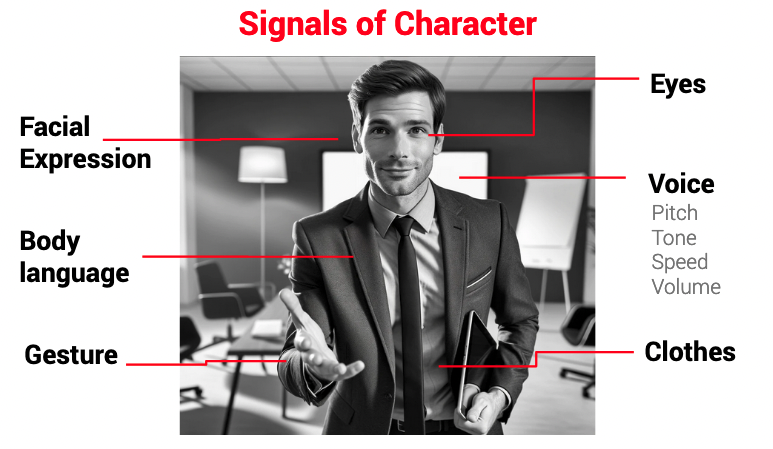
When Ron Popeil, ‘King of the Pitchmen”, pitches something (“Slices tomatoes so thin, they only have one side!”), we use all our senses to hoover up and process signals from all these channels: facial expression, body language, clothes, gesture, eyes, and voice (including things like pitch, tone, speed and volume).
For marketing content (unless it’s video with a person), all of these channels are closed. All we have is tone of voice: how the sender is speaking to us.
And because we only have this one, thin filament to carry all this important information about intention/motivation/character, the reader/viewer/listener values it disproportionately.
The areas of the brain that process decisions and rational analysis are totally different from the parts of the brain that process social signals. When you meet someone new, you’re always processing these signals.
I’d argue the same thing happens when you consume a piece of content: a part of your brain is constantly asking things like, “Who is this? What are they like? What do they want? Are they friend or foe?”—then using whatever signals it picks up to answer these questions.
The new B2B tone of voice
How businesses market to other businesses has changed a lot over the last few years and that’s had a big impact on the B2B voice.
All business relationships start with trust. That part has not changed.
What has changed is the way that a business today earns trust from a person in another business.
Businesses used to earn trust through things like authority, tradition and scale. By being solid, serious, and reliable.

Scale, stone, pillars… the stuff trust used to be built on.
Today, these same qualities are more likely to trigger suspicion.
Instead, trust comes from things like authenticity, transparency and simplicity. And that calls for a completely different voice. One that’s more open, simple and conversational.
Qualities like this should be a part of pretty much every B2B voice. There’s a lot of room for shaping and spinning your voice from there, but these fundamentals are likely to be important:
Look ’em in the eye. Say what you mean. Avoid dressing up ten-cent ideas in nine-dollar prose. Be nice. Be honest. Be real.
But maybe we should be more specific…
How to create a strong tone of voice
Okay, we’ve done the Why part. Now let’s drill down into the How.
Here are 11 things to keep in mind as you develop a strong, clear, compelling tone of voice for your company.
1. Actively manage your ToV
If tone of voice is a strategic asset, you need to manage it like one.
Make it somebody’s job (or an explicit part of their job). Done right, it’s actually a fun gig.
The idea is to be a coach, not a cop. The best stewards of voice spend more time urging people to push their writing further than they do getting people to rein it in. You need someone who understands the voice better than anyone and can help others discover it.
Train it in. Make sure all new hires and everyone who writes for the brand learn about it—especially editors and approvers. Senior executives need to buy in to the tone of voice before they review copy (see A Stakeholder Through The Heart to share a good, long cry about this.)
Capture it in a set of guidelines. There are some great ones to copy from, like The Universty of Leeds one and the awesome MailChimp one.
The first rule of tone of voice guides is this: write it in your tone of voice (duh). You’d be amazed at how many ToV guides are written in a gluey mix of brand-speak, Kool-Aid and legalese. Yours should be the single best demonstration of the voice you’re defining and promoting.
The second rule of ToV guides: use lots of examples. Before-and-Afters. Dos and Don’ts. Makeovers. Writing about writing can become awfully abstract. Examples make things concrete and practical.
Tone of voice guidelines and training are important but they’re not very scalable. If you’ve got a really big content operation (including not just marketing but tech documentation and customer support content) you’ll also want some kind of content governance software. Our friends at Acrolinx make one and it’s pretty amazing (you can score a piece of text against your content strategy, brand terms and tone of voice guidance and help the writer raise that score themselves. Very cool.)
2. Know who you are: tone of voice starts with brand
How you speak needs to come from who you are. From your brand.
If you’re brand is fuzzy, it’s hard to develop a clear, consistent voice. But if you know exactly who you are, voice springs naturally from that.
The University of Leeds tone of voice guide includes this chart, showing the nested relationships between Vision, Big Idea, Principles and Personality. The voice guidelines (straightforward, friendly, confident…) are in the Personality layer.

The guidance is clear because the brand is clear.
A lot of voice problems can be tracked back to brand problems. To companies that don’t really know who they are, or who want to be all things to all people (as fatal to a great voice as it is to great marketing).
A voice that’s disconnected from its brand is like a person trying to keep up an accent for a whole day. It’s just not who you are, so it doesn’t ring true—and it’s really hard to stay in character.
But when you tap into something real about your company, voice becomes natural. Everyone in the company can express themselves in the voice. Because it’s not an act.
3. Start with a voice strategy statement
Before breaking down your voice into its constituent parts, try to summarize it in a few paragraphs. Talk about your customers. About where their needs meet your solutions and how voice should reflect that.
This is your voice strategy statement—the WHY behind your voice decisions—and it’s the most important thing you can do. Craft it carefully.
I love Mailchimp’s version of this:
“At Mailchimp, we’ve walked in our customers’ shoes, and we know marketing technology is a minefield of confusing terminology. That’s why we speak like the experienced and compassionate business partner we wish we’d had way back when.
We treat every hopeful brand seriously. We want to educate people without patronizing or confusing them.
Using offbeat humor and a conversational voice, we play with language to bring joy to their work. We prefer the subtle over the noisy, the wry over the farcical. We don’t take ourselves too seriously.
Whether people know what they need from us or don’t know the first thing about marketing, every word we say informs and encourages. We impart our expertise with clarity, empathy, and wit.”
From the Mailchimp Content Style Guide
Isn’t that lovely? They go on to describe the elements of the Mailchimp voice, but you almost don’t need anything more. I feel I could write for them based on this statement alone.
4. Choose three base notes.
Four at most.
You can think of tone of voice creation like building up a perfume, with a few base notes that don’t vary much and then some accent notes that will vary according to context and audience.
Limiting yourself to three or four base notes is a good discipline. It forces some choices, making it harder to throw everything in (which leads to that all-things-to-all-people trap).
Try to make your base notes qualities that aren’t something every brand would choose. “Human” probably shouldn’t be one of them (what other species would you be writing for?).
For the University of Leeds example, “Straightforward” might sound like a quality every brand would want. But that’s not always true. A luxury brand might go for ‘luxe-babble’ (‘timepiece’ my arse) and a super-techie data science company might want to signal geeky precision.
In the ‘Straightforward’ section, the University of Leeds guide says:
“What we mean by Straightforward: Clear, uncomplicated, easy to understand and single-minded.
What we don’t mean: Dumbed down, patronising, facile, lacking in substance.
How does ‘straightforward’ sound? Straightforward doesn’t mean that we’re over-simplifying or being patronising. It means that we avoid over-complicated terminology and jargon that is exclusive to our sector or discipline. We make our language as easy as possible to understand. People don’t have time to wade through complex and long-winded explanations and we stand a much better chance of getting our message across if we keep it simple…”U. of Leeds ToV guide
The guide then gives specific tips for straightforwardness. Short sentences, single-minded, less jargon. Stuff like that.
Let’s look at some well-known brands and reverse engineer their three base notes (my guesses, not from their guidelines). We’ll start with a consumer brand because they’re good at it.
Innocent Drinks: Simple. Friendly. Silly.
Here’s a typical bit of pack copy:

When the Innocent brand was born this was fresh, super-compelling stuff. Today, so many brands have copied it that it’s lost some of its mojo and can now stray dangerously over the dreaded Cute Line. (Cute sucks unless your product is teddy bears or porcelain pixies.)
To analyze a brand’s voice, I often go to the Careers page of their website. You can tell a lot from how they talk about their own people. Here was a chunk from Innocent’s site:
“We want to create a business we can be proud of. So to make this happen, we need brilliant people who inspire and deliver change all around them. That’s why we’re always looking for talented, ambitious and altruistic folks to come and join us.”
Innocent careers page, from a while back
I like this a lot more than the pack copy. Phrases like “a business we can be proud of” and “altruistic folks” don’t just talk about their culture, they demonstrate that culture.
Simple. Friendly. Sometimes silly.
Hubspot: Enthusiastic. Positive. Helpful.
Pick anything Hubspot puts out and you’ll feel these three base notes.
It’s essentially a hug-centric marketing cult and their voice is a major part of that. From their careers page:
“Choose your adventure.Each team at HubSpot features its own unique blend of passion, personality, and panache. Choose the one that most feels like home.”
Hubspot careers page
The fun alliteration. The direct appeal to the reader with the second-person “your” instead of the impersonal third-person. The idea that the choice is yours, not theirs… all very huggy.
Your three base notes are your voice tripod. They give you the solid, foundation guidelines for everything you say. Then the nuance comes in…
4. Pick some accent notes
Accent notes let you adapt your tone of voice for specific audiences and situations. To take context into account.
I’m still the same person to my kids, my clients, my friends and my bank. But I don’t speak the same way to all of them. It would be weird if I did.
I like to think of accent notes as sliders that let you take a given dimension and ramp it up or down. Like these, using paired opposites on a spectrum:
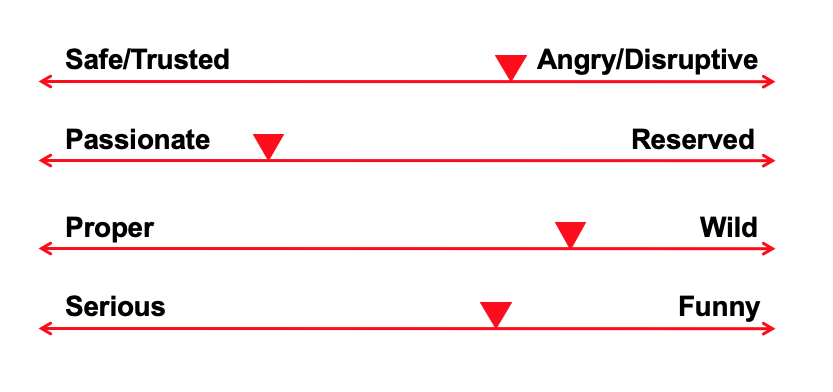
The idea isn’t to nail the sweet spot on each spectrum forever, but to be able to slide left and right, within an acceptable zone, as context dictates.
Jack Daniels has cultivated a super-focused, down-home voice but you wouldn’t want to hear it everywhere in all its folksy glory. If your credit card gets denied when buying a ticket to their distillery tour, you probably don’t need to hear, “Your card has been flat-out denied. Y’all come back when you got more money. We’ll be here.”
The goal with base notes and accents isn’t to have an identical voice everywhere. It’s more like consistent variety. Same speaker, slightly different tones for different situations.
The old-school brand police types hate variation. that comes from a misguided understanding of what a brand is. And it leads to boring.
5. Craft your microcopy
Microcopy is the stuff most brands never think about. The error messages. The tiny little hints and guides in an ecommerce checkout process. The disclaimers, terms & conditions and product FAQs .
But microcopy can be a great carrier of your brand personality. It’s a great place to show your tone of voice because it’s unexpected. People feel they’re seeing the real you when they read your microcopy. As if this must be who you really are if you speak this way when no one is watching.
And, for a lot of brands, microcopy does betray their true character. All those smiles and conversational touches fall away to reveal the commercial enterprise underneath.
I found my favorite example of a brand mask falling away on the website for Ritz Carlton Residences. As you’d expect, the voice is all sycophantic luxe-speak, like this:
“Imagine a home not only defined by sophisticated style and luxurious finishes, but equipped to deliver legendary Ritz-Carlton service. From concierge services and in-residence dining to a dedicated residential management team, a lifestyle of privacy and comfort awaits.”
Sounds like obsequiousness is a calling. But when I clicked the call to action, the lawyers tromped in:
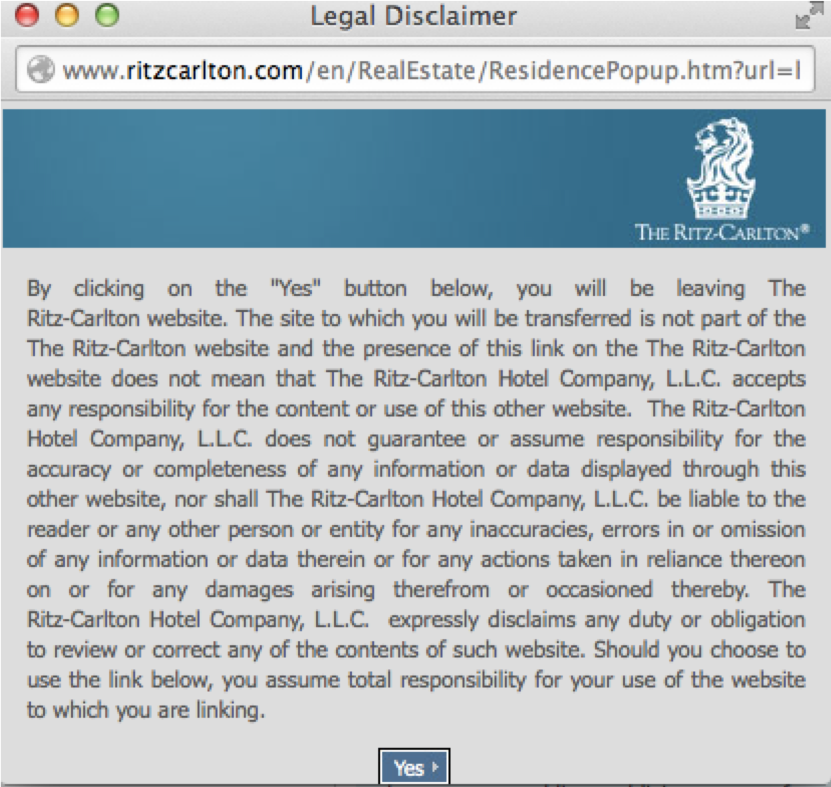
Yikes. Looks like that “lifestyle of privacy and comfort” may depend on the integrity of whatever developer Ritz Carlton licensed their veneer-thin brand to.
So that’s how not to do microcopy. Here are a few better examples.
Chubbies sells shorts online. Here’s one of their call-to-action panels:

Each of the CTAs is on-brand and in voice. And it’s the first time I’ve ever seen “Boomshakalaka!” as button copy.
Our own newsletter sign-up (you have signed up haven’t you?) taps into our anti-marketing vibe:

And when you do opt in, the thank-you copy is a bit of a parody too:
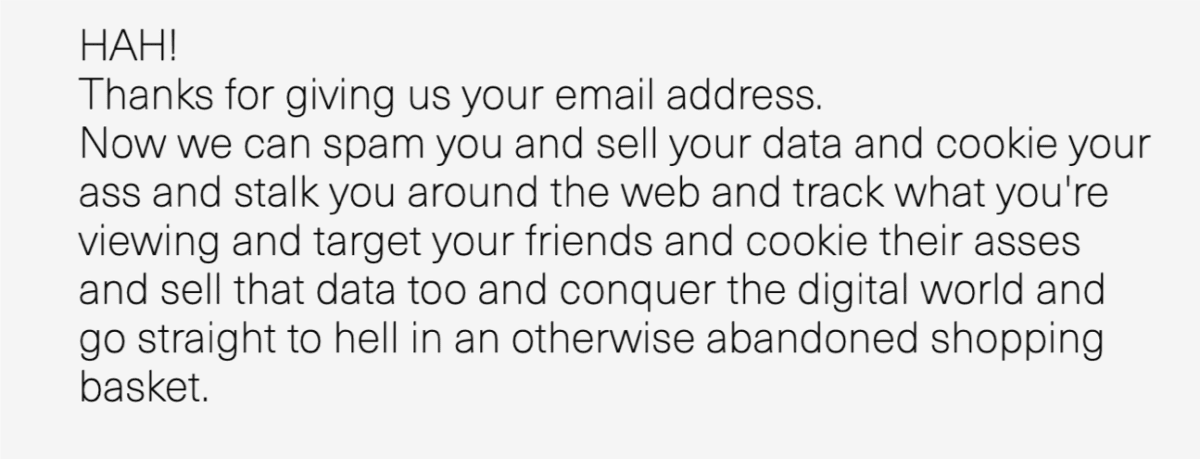
We get more comments about that then we get about our actual newsletter.
Microcopy is a fun low-risk channel—a great place to take your tone of voice out for a spin.
6. Use wit and charm but be careful with comedy
People like buying from people who enjoy what they do. Unless you’re in the root canal trade, it’s probably a good thing to try to signal that.
Wit and charm are a legitimate target here. But full-fat comedy is probably not. Comedy is like leaping a canyon in a jet-powered rocket-bike. Just one foot short and you’re at the bottom, in the Valley of Cringe. Wearing a spangly jumpsuit. In public. (Been there. Walked the walk of shame.)
We like to use what we call ‘winks’—little signals that say we like what we do and we like the reader. Like this, from a piece called Crap: Why the biggest threat to content marketing is content marketing:
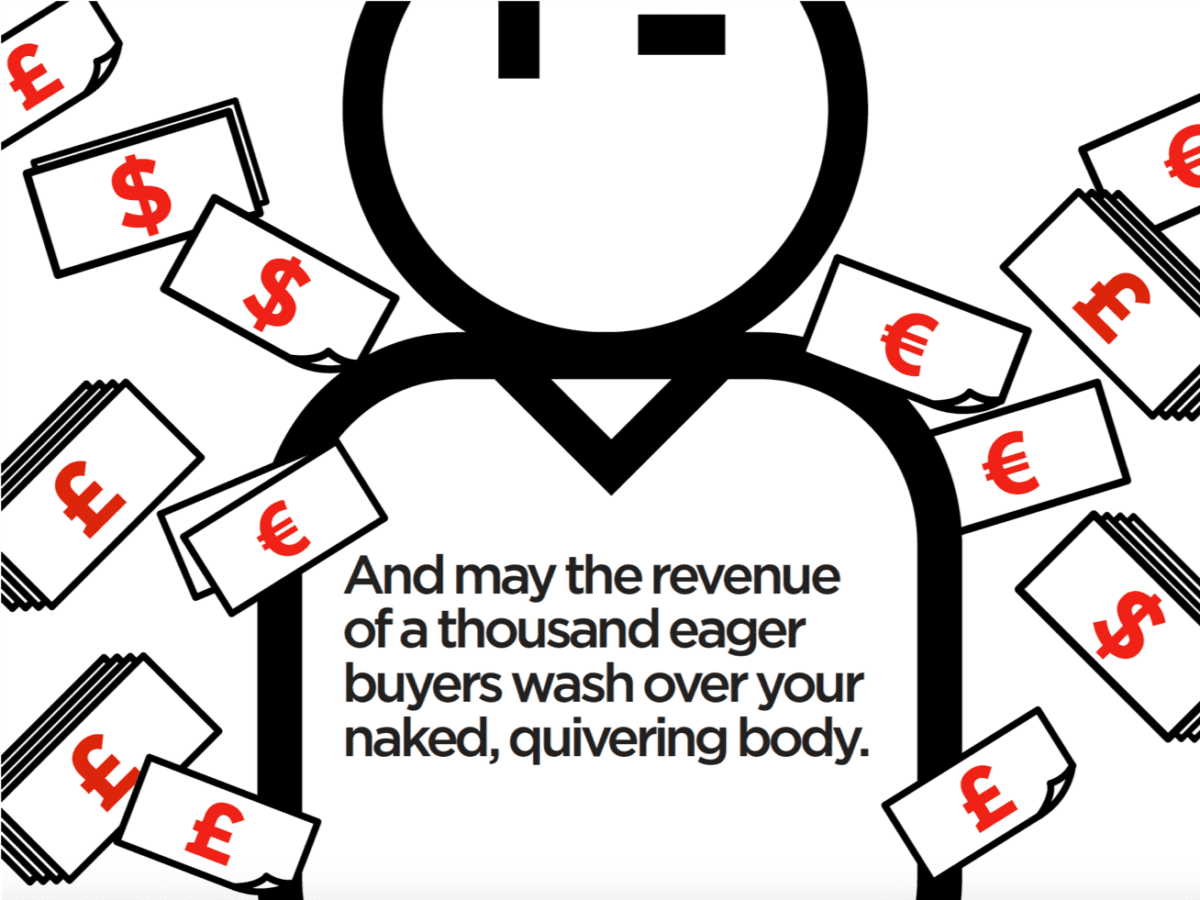
Yes, we could have just said, “We hope you succeed in improving your marketing metrics”… but it’s a wink. (Our designers are terrific at inserting visual winks too. In the page above it’s a literal one.)
7. Explore a conversational style
‘Casual’ or ‘flippant’ may not fit your brand but ‘conversational’ probably does. A piece of content is a person talking to another person.
But what makes writing conversational? Here are a few things:
Contractions – We all use them in speech all the time. But when some writers write, they straighten up and expand out all their contractions. It sounds stiff.
Sentence fragments – The grammar pedants hate this but real people talk in sentence fragments all the time. Not clunky constructions that somehow lost their subjects or verbs. Just little chunks. Like that one. And this one.
Conversational signals – Little phrases that people say all the time but don’t tend to include in their writing. Like, “Here’s the thing,” or “Think about that.” (Luke touches on this one in his excellent post, Let’s Steal from 17th Century Explorers.)
If your editors are scrubbing these things out in the (misguided) name of grammatical correctness, hit them with that Nerf bat you keep in the corner for just this purpose.
Conversational signals often make prose a bit longer. That’s fine. Like most writing rules, the rule that shorter is always better isn’t really a rule at all. It’s a guide.
8. Stomp out yucky words.
There are words people only ever write and never say. Puffed-up ‘writerly’ words that evoke the image of someone typing with a yardstick stuck down the back of their shirt.
There are lots of lists of these. The one in the Monzo tone of voice guide is my favorite:
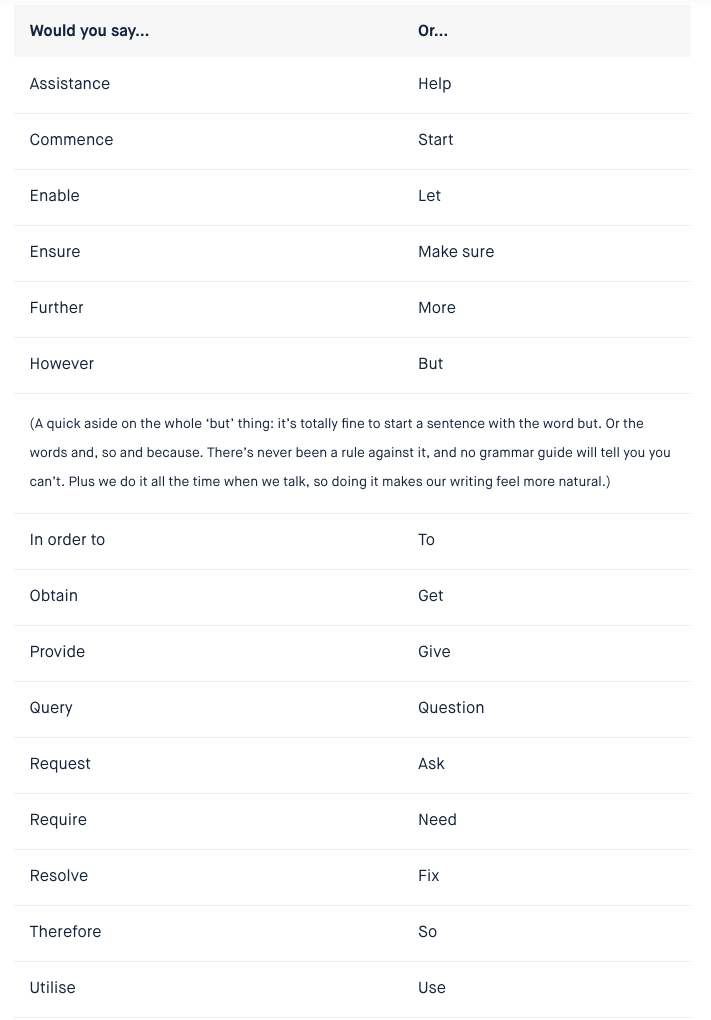
9. Use the right jargon in the right amounts
It’s too simplistic to say that all jargon is bad. It isn’t.
I forget who said that jargon is like cholesterol: there’s a good kind and a bad kind. But I’m gonna pretend it was me.
Good jargon is like shorthand, speeding communications between fellow insiders. To a sales leader, “CRM” is not pretentious tech-speak. Using it shows you know something about sales, while avoiding it signals you don’t.
Bad jargon tries to hide something. To fake intelligence or experience, simulate knowledge or manufacture a sense of importance. It invariably fails to do all of these things.
(Harry wrote a great post about jargon called Buzzwords are Blankets that you’ll want to read.)
10. Don’t be afraid to be negative.
This one always crops up and it’s depressing. Some Dale Carnegie groupie must have written a book telling people to avoid anything negative in their marketing.
I’d like to hunt that person down and beat them with their own book.
Humans have a wide range of emotions and some of the most powerful, vivid, visceral ones are negative (my personal favorites are hate, anger, fear and disgust but you’ll have your own).
You don’t want to be a negative brand, to look like you have a chip on your shoulder, but to deny your writers access to the rich goodies of negativity is to tie their hands behind their backs and ask them to type with their noses. They can probably do it but… why?
It’s not only okay to get angry about certain things—principally about the obstacles to your prospects’ success—it’s almost required. Marketing is about selling solutions to problems. Selling the problem is a huge part of that. Problems are negative. Get over it.
(Andrew covers this beautifully in When Bad Is Good: In Defense of the Negative.)
11. Find great writers.
This is important. It’s really hard to maintain a great voice for your brand if you hire mediocre writers.
Unfortunately, it’s hard enough to find writers who can simplify complex, B2B things. Holding out for writers who can also write with a strong, clear, confident voice? Well, that reduces your talent pool dramatically. (Which sucks: our ratio of writer applicants to offers is homeopathic.)
But just because finding great writers is really, really hard doesn’t mean it isn’t worth the effort. It is.
If I were a new CMO, the first thing I’d do is review everyone who writes for the brand (in-house, freelance and agency) and replace the good ones with great ones. The impact on the brand’s voice is instant and lasting.
Invest in your voice
I hope I’ve convinced you that your brand’s voice should be one of your most valuable assets. Invest in creating a great one and the dividends accrue everywhere you talk with your prospects and customers, from first contact to ten-year anniversary.
No, it’s not an easy win. It takes commitment, talent, nuance and strategic clarity. But how many other things can multiply the impact of your marketing?
Some tone of voice resources and references
Everybody Writes by Ann Handley is the book for full-time content and brand writers and for people who commission, brief and review writers.
Copyblogger produces a great blog, content and training about writing.
Acrolinx makes Active Content Governance software that helps keep all writing on-strategy and on-brand (including tone of voice guidance and governance). Very cool. [Disclosure: a client… but do check it out.]
MailChimp’s Voice and Tone Guide – one of the best I’ve seen.
Monzo’s Guide – is right up there with the best. Voice has been a huge part of their success.
Some of our posts about voice and writing:
Harry’s one on buzzwords and jargon
Andrew’s one on the positive power of negativity.
Luke’s one on rhetoric and 17th century explorers.
One on the relationship between voice and stance.
Six examples of Insane Honesty in content marketing.
The 15 copywriters I don’t want to be.
(BTW – This post came out of a talk I did on Tone of Voice at a few different conferences a while back).

Enjoyed this article?
Take part in the discussion








Comments
Fin Wycherley Supersize Media July 1st, 2019
OMG, it’s not SOS copy, it’s LOL copy! Nobody is in the same league of being able to hit the copygasm every single time, time and time again … relentlessly :))) Love it, Doug!
Doug Kessler July 7th, 2019
Copygasm. My vocabulary just grew by one, brand new word.
Thanks, Fin!
Tish July 16th, 2019
I especially appreciated the section on stomping out yucky words. I (shouldn’t admit that I) listen to a lot of young adult sci-fi/fantasy fiction, and the consistent use of yucky words and phrases from literally ALL the authors leads me to believe there is one maniac editor out there trying to bring phrases like “gain purchase” to the main stream.
Joanne Parker October 22nd, 2019
Brilliant post. Agree wholeheartedly with you. Having introduced the TOV concept to a number of companies it is not always an easy sell. Some think you are just talking about plain English, whilst others worry about dumbing down. I do think that making sure a company really understands brand and brand personality is paramount to success.
Doug Kessler October 29th, 2019
Amen, Joanne. There are enough strong examples of voice driving successful brands — but maybe it feels too nuanced to approach it strategically…